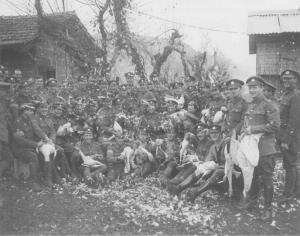It is possible that a strain of influenza virus having rates of morbidity and mortality similar to those of the Spanish flu could arise again. Although the Spanish flu was a particularly lethal strain of the virus, it occurred at a time when soldiers and civilians were living in conditions that encouraged the spread of any disease; and infections reached their zenith at a time when soldiers were on the move — across Europe; and home to North America, Australia, and Asia.

In the army camps of Europe men and women were living in crowded conditions. In many camps there were livestock – fowl and pigs being farmed for food, and horses for transportation.[1] With autumn’s arrival came the rain, and then mud — ideal conditions for the spread of disease.
There have been pandemics from time to time since the Spanish Influenza and most of the viruses involved have contained some proteins of the Spanish version; but the constant efforts of medical researchers to both understand the disease and to be prepared for the next version of the virus, mitigate against such a cataclysmic event.[2]
1. J. S. Oxford, “The So-Called Great Spanish Influenza Pandemic of 1918 May Have Originated in France in 1916″, Philosophical Transactions: Biological Sciences, Vol. 356, No. 1416, The Origin and Control of Pandemic Influenza (Dec. 29, 2001), pp. 1857-1859, p. 1857. < http://www.jstor.org/stable/3067060> accessed on 14 March 2014.
2. Adolfo García-Sastre and Richard J. Whitley, Lessons Learned from Reconstructing the 1918 Influenza Pandemic,The Journal of Infectious Diseases, Vol. 194, Supplement 2. Seasonal and Pandemic Influenza: At the Crossroads, a Global Opportunity (Nov. 1, 2006), pp. S127-S132, passim. < http://www.jstor.org/stable/30086133> accessed on 18 March 2014.
